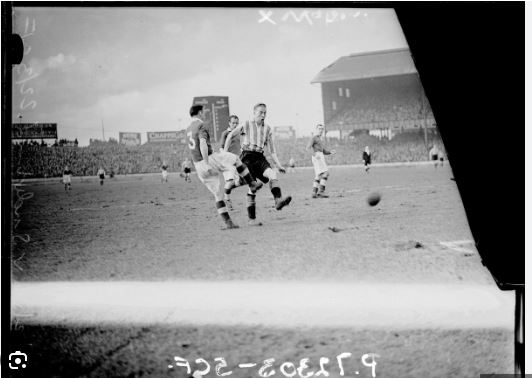
Sunderland’s first full season following WWII saw us finish in a respectable ninth place, with many new players settling in. Going into the 1947/1948 season with hope, the need for goals was a problem if we were to improve on our 1946/1947 campaign.
Unfortunately, the season had not begun off well. Our highest place was fourteenth at Christmas, and we’d spent much of the season hovering about the relegation zone.
Sunderland entered the season’s penultimate game against Middlesbrough with the potential of their first relegation, but the board was not idle.
At the end of November, we signed Ronnie Turnbull from Dundee for £9,000, making him our record signing. The centre forward began the season on fire, scoring all four goals in a 4-1 thrashing of Portsmouth at Roker Park, but he would only score four more goals the rest of the way.
However, on Valentine’s Day, we saw the debut of a player who a generation or two would fall in love with and grow to regard as maybe our greatest ever entertainer, when Newcastle bought Len Shackleton for a then-British record cost of £20,050.
:no_upscale()/cdn.vox-cdn.com/uploads/chorus_asset/file/25413820/1242212.jpg)
Bids were made in sealed envelopes, and it’s claimed that we were gently persuaded to contribute the extra £50 if we wanted to keep our man!
Putting aside the questionable payment methods, we were able to secure him, and by the end of the season, Shackleton had added almost 10,000 to every home gate, with the average attendance rising from 38,016 to 49,608.
Despite the ‘Shack effect’, we were in nineteenth place when Middlesbrough arrived, and we were in serious risk of dropping if the results went against us.
Our defense had a familiar look, with Johnny Mapson in goal and fullbacks Jackie Stelling and Arthur Hudgell were supported by a halfback line that included Reg Scotson, left half Arthur Wright (reputedly blessed with the strongest shot in football at the time), and captain Fred Hall, a player of huge physical stature and presence on the pitch.
Willie Watson, an internationally capped football and cricket player, would occasionally drop into the half back line to cover for injuries and would eventually move there permanently in subsequent seasons.
Our front five took some time to establish themselves, but by the end of the season, the guys in the shirts were Len Duns, Jackie Robinson, Dick Davis, Shackleton, and Tommy Reynolds.
:no_upscale()/cdn.vox-cdn.com/uploads/chorus_asset/file/25413835/637419204.jpg)
Duns, a local, made his debut on the right flank in 1935 and played throughout the league-winning 1935/1936 and FA Cup-winning 1936/1937 seasons.
At inside right, Shiremoor-born Robinson had started his career at Sheffield Wednesday before the war and arrived at Sunderland in the fall of his career, scoring a total of 34 goals in
Eighty-five appearances.
Davis, however, switched between centre striker and inside right during his career at Sunderland, and after fending off Ronnie Turnbull’s challenge, he led the line heading into this game, eventually scoring 79 goals in 150 appearances.
Reynolds, a Felling native who was said to be as fast as the greyhounds he trained and raced on the Sunderland track, was on the left wing and establishing a burgeoning partnership with ‘Shack’.
Shackleton, playing inside left, would become a legend not only at Sunderland, but throughout the game.
I can personally attest to his attractiveness, with my Newcastle-supporting father and brother describing him as the best player they had ever seen and reminding me of the ‘Clown Prince’s’ abilities whenever I dared to suggest a new kid on the block!
Middlesbrough, however, arrived with their own ‘golden boy’ in the form of Wilf Mannion, an inside forward with pedigree and character. However, both he and Shackleton would find themselves effectively frozen out of this game, with the outcome far more essential than entertaining at this point in the season.
:no_upscale()/cdn.vox-cdn.com/uploads/chorus_asset/file/25413860/637445024.jpg)
Given the stakes and the players involved, most press reports mention the ‘tameness and scarcity of amusement’ available to the rowdy 51,000+ attendees.
Sunderland was the better team throughout, although we took the lead after six minutes thanks to a lucky goal.
Arthur Wright struck a free kick into the corridor of doubt; Davis attempted to head the ball but failed completely, deceiving Middlesbrough goalkeeper Derrick Goodfellow as the ball slipped through his hands and into the net.
There was little goalmouth action in the first half as the game stalled around midfield.
The second half continued in a similar vein, with only the energetic Reynolds demonstrating urgency and ability to create, and on 53 minutes, he beat his man all ends up and forced a corner from almost nothing.
He took the kick himself and arrowed the ball onto Robinson’s head, who had ghosted into the six-yard box before flicking it past the immovable Goodfellow to put us ahead 2-0.
:no_upscale()/cdn.vox-cdn.com/uploads/chorus_asset/file/25413885/637419028.jpg)
On sixty-nine minutes, Arthur Wright lined up a free kick from thirty yards.
Wright was well-known for his dead ball shooting at the time, and the Middlesbrough defenders anticipated this when he ran in as if to shoot and passed the ball laterally to Davis, who first fumbled.
This is one of the game’s peculiarities, as it frequently creates space and reluctance in defence, which is exactly what happened. Time appeared to stand still as Davis furiously toe prodded the ball, which went past Goodfellow for 3-0.
That was the extent of the remaining entertainment.
Reynolds had put in a ‘player of the match’ effort, and we eventually concluded the season in twentieth place, putting the campaign to rest and preparing for what we hoped would be a successful run at the league and cup in 1948/1949.
Unfortunately, Yeovil might have something to say about our Cup ambitions!
Leave a Reply